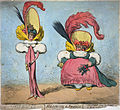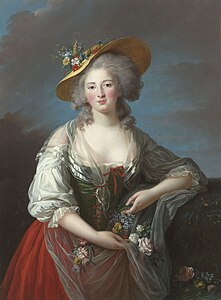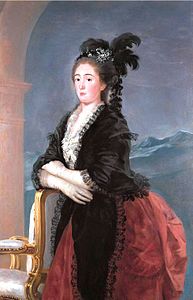Fashion in 1775-1785, or the Louis XVI style fashion,is developed in France during the 19-year reign of Louis XVI (1774–1793), just before the French Revolution. It saw the final phase of the baroque style as well as the birth of French neoclassicism. The style was a reaction against the elaborate ornament of the preceding baroque period. Its features included the straight column, the simplicity of the post-and-lintel, the architrave of the Greek temple. It also expressed the Rousseau-inspired values of returning to nature and the view of nature as an idealized and wild but still orderly and inherently worthy model for the arts to follow.
In 1774, Louis XVI succeeded his grandfather. He marries Marie Antoinette of Austria. France has many problems, but Marie-Antoinette and the nobility continue to waste money. There is a desire for simplicity and nature that was difficult to reconcile with the complicated costumes and hairstyles. From 1780 a British country style à l’anglaise develops; the clothes become more practical and simpler. The steam machine in spinning mills and weavers brings a large supply of cotton to mainland Europe.
Around 1770, the robe à la polonaise fashion, a dress with a suspended skirt (actually farm fashion). The powdered hair is laid out sky-high: real hair is combined with horsehair in a metal or cushions construction. The hairstyles are exuberantly decorated with pearls, jewelery, plumes and pieces of fabric. Whole scenes are processed in the hair, such as a ship or a farm. Such a precious building remains for months; hence women wore scraps. Characteristic is also the large production of lace , which is a luxury object par excellence. Rose Bertin, the fashion designer of Marie-Antoinette, sets the trend for the robe chemise or batiste: comfortable gowns without hoops and whalebones.
Fashion between 1775–1785 in Western culture became simpler and less elaborate. These changes were a result of emerging modern ideals of selfhood, the declining fashionability of highly elaborate Rococo styles, and the widespread embrace of the rationalistic or “classical” ideals of Enlightenment philosophes.
Women’s fashion
Overview
Women’s clothing styles maintained an emphasis on the conical shape of the torso while the shape of the skirts changed throughout the period. The wide panniers (holding the skirts out at the side) for the most part disappeared by 1780 for all but the most formal court functions, and false rumps (bum-pads or hip-pads) were worn for a time.
Marie Antoinette had a marked influence on French fashion beginning in the 1780s. Around this time, she had begun to rebel against the structure of court life. She abolished her morning toilette and often escaped to the Petit Trianon with increasing frequency, leading to criticism of her exclusivity by cutting off the traditional right of the aristocracy to their monarch. Marie Antoinette found refuge from the stresses of the rigidity of court life and the scrutiny of the public eye, the ailing health of her children, and her sense of powerlessness in her marriage by carrying out a pseudo-country life in her newly constructed hameau. She and an elite circle of friends would dress in peasant clothing and straw hats and retreat to the hameau. It was out of this practice that her style of dress evolved.
By tradition, a lady of the court was instantaneously recognizable by her panniers, corset and weighty silk materials that constructed her gown in the style of à la française or à l’anglaise. By doing away with these things, Marie Antoinette’s gaulle or chemise á la Reine stripped female aristocrats of their traditional identity; noblewomen could now be confused with peasant girls, confusing long standing sartorial differences in class. The chemise was made from a white muslin and the queen was further accused of importing foreign fabrics and crippling the French silk industry. The gaulle consisted of thin layers of this muslin, loosely draped around the body and belted at the waist, and was often worn with an apron and a fichu. This trend was quickly adopted by fashionable women in France and England, but upon the debut of the portrait of Marie Antoinette by Elisabeth Vigée-Lebrun, the clothing style created a scandal and increased the hatred for the queen. The queen’s clothing in the portrait looked like a chemise, nothing more than a garment that women wore under her other clothing or to lounge in the intimate space of the private boudoir. It was perceived to be indecent, and especially unbecoming for the queen. The sexual nature of the gaulle undermined the notions of status and the ideology that gave her and kept her in power. Marie Antoinette wanted to be private and individual, a notion unbecoming for a member of the monarchy that is supposed to act as a symbol of the state.
When Marie Antoinette turned thirty, she decided it was no longer decent for her to dress in this way and returned to more acceptable courtly styles, though she still dressed her children in the style of the gaulle, which may have continued to reflect badly on the opinion of their mother even though she was making visible efforts to rein in her own previous fashion excess. However, despite the distaste with the queen’s inappropriate fashions, and her own switch back to traditional dress later in life, the gaulle became a popular garment in both France and abroad. Despite its controversial beginnings, the simplicity of the style and material became the custom and had a great influence on the transition into the neoclassical styles of the late 1790s.
During the years of the French Revolution, women’s dress expanded into different types of national costume. Women wore variations of white skirts, topped with revolutionary colored striped jackets, as well as white Greek chemise gowns, accessorized with shawls, scarves, and ribbons.
By 1790, skirts were still somewhat full, but they were no longer obviously pushed out in any particular direction (though a slight bustle pad might still be worn). The “pouter-pigeon” front came into style (many layers of cloth pinned over the bodice), but in other respects women’s fashions were starting to be simplified by influences from Englishwomen’s country outdoors wear (thus the “redingote” was the French pronunciation of an English “riding coat”), and from neo-classicism. By 1795, waistlines were somewhat raised, preparing the way for the development of the empire silhouette and unabashed neo-classicism of late 1790s fashions.
Gowns
The usual fashion at the beginning of the period was a low-necked gown (usually called in French a robe), worn over a petticoat. Most gowns had skirts that opened in front to show the petticoat worn beneath. As part of the general simplification of dress, the open bodice with a separate stomacher was replaced by a bodice with edges that met center front.
The robe à la française or sack-back gown, with back pleats hanging loosely from the neckline, long worn as court fashion, made its last appearance early in this period. A fitted bodice held the front of the gown closely to the figure.
The robe à l’anglaise or close-bodied gown featured back pleats sewn in place to fit closely to the body, and then released into the skirt which would be draped in various ways. Elaborate draping “à la polonaise” became fashionable by the mid-1770s, featuring backs of the gowns’ skirts pulled up into swags either through loops or through the pocket slits of the gown.
Front-wrapping thigh-length shortgowns or bedgowns of lightweight printed cotton fabric remained fashionable at-home morning wear, worn with petticoats. Over time, bedgowns became the staple upper garment of British and American female working-class street. Women would also often wear a neck handkerchief, sometimes for modesty reasons. In surviving artwork, there are few women depicted wearing bedgowns without a handkerchief. These large handkerchiefs could be of linen, plain, colored or of printed cotton for working wear. Wealthy women wore handkerchiefs of fine, sheer fabrics, often trimmed with lace or embroidery with their expensive gowns.
Jackets and redingotes
An informal alternative to the dress was a costume of a jacket and petticoat, based on working class fashion but executed in finer fabrics with a tighter fit.
The caraco was a jacket-like bodice worn with a petticoat, with elbow-length sleeves. By the 1790s, caracos had full-length, tight sleeves.
As in previous periods, the traditional riding habit consisted of a tailored jacket like a man’s coat, worn with a high-necked shirt, a waistcoat, a petticoat, and a hat. Alternatively, the jacket and a false waistcoat-front might be a made as a single garment, and later in the period a simpler riding jacket and petticoat (without waistcoat) could be worn.
Another alternative to the traditional habit was a coat-dress called a joseph or riding coat (borrowed in French as redingote), usually of unadorned or simply trimmed woolen fabric, with full-length, tight sleeves and a broad collar with lapels or revers. The redingote was later worn as an overcoat with the light-weight chemise dress.
Underwear
The shift, chemise (in France), or smock, had a low neckline and elbow-length sleeves which were full early in the period and became increasingly narrow as the century progressed. Drawers were not worn in this period.
Strapless stays were cut high at the armpit, to encourage a woman to stand with her shoulders slightly back, a fashionable posture. The fashionable shape was a rather conical torso, with large hips. The waist was not particularly small. Stays were usually laced snugly, but comfortably; only those interested in extreme fashions laced tightly. They offered back support for heavy lifting, and poor and middle class women were able to work comfortably in them. As the relaxed, country fashion took hold in France, stays were sometimes replaced by a lightly boned garment called “un corset,” though this style did not achieve popularity in England, where stays remained standard through the end of the period.
Panniers or side-hoops remained an essential of court fashion but disappeared everywhere else in favor of a few petticoats. Free-hanging pockets were tied around the waist and were accessed through pocket slits in the side-seams of the gown or petticoat. Woolen or quilted waistcoats were worn over the stays or corset and under the gown for warmth, as were petticoats quilted with wool batting, especially in the cold climates of Northern Europe and America.
Footwear and accessories
Shoes had high, curved heels (the origin of modern “louis heels”) and were made of fabric or leather. Shoe buckles remained fashionable until they were abandoned along with high-heeled footwear and other aristocratic fashions in the years after the French Revolution, The long upper also was eliminated, essentially leaving only the toes of the foot covered. The slippers that were ordinarily worn with shoes were abandoned because the shoes had become comfortable enough to be worn without them. Fans continued to be popular in this time period, however, they were increasingly replaced, outdoors at least, by the parasol. Indoors the fan was still carried exclusively. Additionally, women began using walking sticks.
Hairstyles and headgear
The 1770s were notable for extreme hairstyles and wigs which were built up very high, and often incorporated decorative objects (sometimes symbolic, as in the case of the famous engraving depicting a lady wearing a large ship in her hair with masts and sails—called the “Coiffure à l’Indépendance ou le Triomphe de la liberté”—to celebrate naval victory in the American war of independence). These coiffures were parodied in several famous satirical caricatures of the period.
By the 1780s, elaborate hats replaced the former elaborate hairstyles. Mob caps and other “country” styles were worn indoors. Flat, broad-brimmed and low-crowned straw “shepherdess” hats tied on with ribbons were worn with the new rustic styles.
Hair was powdered into the early 1780s, but the new fashion required natural colored hair, often dressed simply in a mass of curls.
Style gallery 1775–1785
 1 – 1776 |
 2 – 1778 |
 3 – 1780 |
 4 – 1783 |
 5 – 1784–87 |
|---|---|---|---|---|
 6 – 1785 |
|
|
|
|
1.Lady Worsley wears a red riding habit with military details, copying those of the uniform of her husband’s regiment (he was away fighting the American rebels) on the cutaway coat and a buff waistcoat, 1776.
2.Marie Antoinette wears panniers, a requirement of court fashion for the most formal state occasions, 1778
3.The Ladies Waldegrave wear transitional styles, 1780–81, in their portrait by Reynolds. Their hair is powdered and dressed high, but their white caracos, like shorter dresses à la polonaise, have long tight sleeves.
4.Marie Antoinette in chemise dress, 1783. She wears a sheer, striped sash and a broad-brimmed hat. Her sleeves are poufed, probably with drawstrings.
5.French robe à l’anglaise with fashionable closed bodice, 1784–87, Metropolitan Museum of Art, New York.
6.Marie Antoinette wears the popularized turban, with a scarf wrapped around it. Her collar is heavy with lace, and her crimson petticoat is trimmed in fur, 1785.
French fashion 1775–1785
|
France, 1775 |
France, 1777 |
France, 1781 |
France, 1782 |
France, 1783 |
|---|---|---|---|---|
|
France, 1784 |
France, 1784 |
France, 1785 |
Spanish fashion 1775–1785
|
Spain, 1775 |
Spain, 1778 |
Spain, 1783 |
Spain, 1785 |
Spain, 1785 |
|---|
Caricature
 |
 |
|---|
1.Miss Shuttle-Cock (1776) compares women’s dresses and feathered headwear to the shuttlecocks used in the sport of Badminton.
2.In Following the Fashion (1794), James Gillray caricatured figures flattered and not flattered by the high-waisted gowns then in fashion.
Source from Wikipedia













